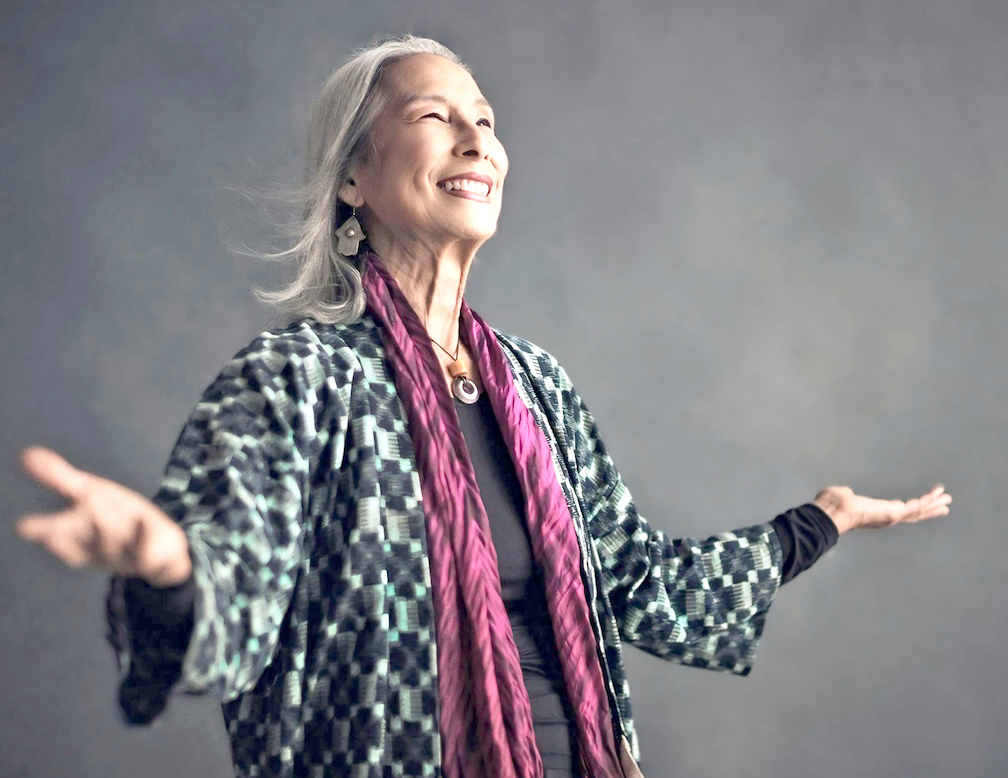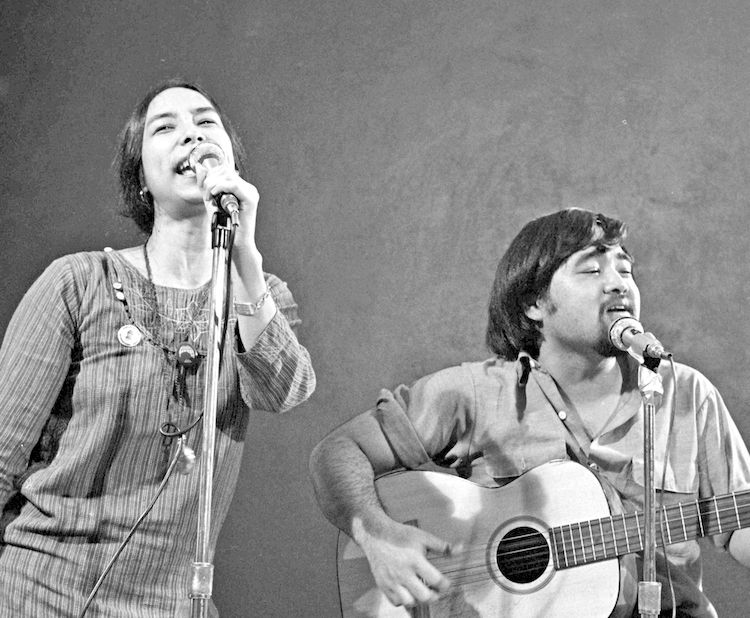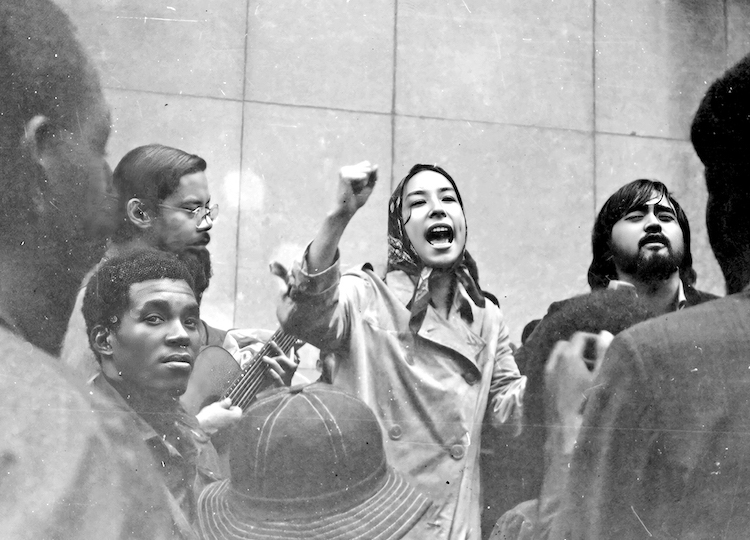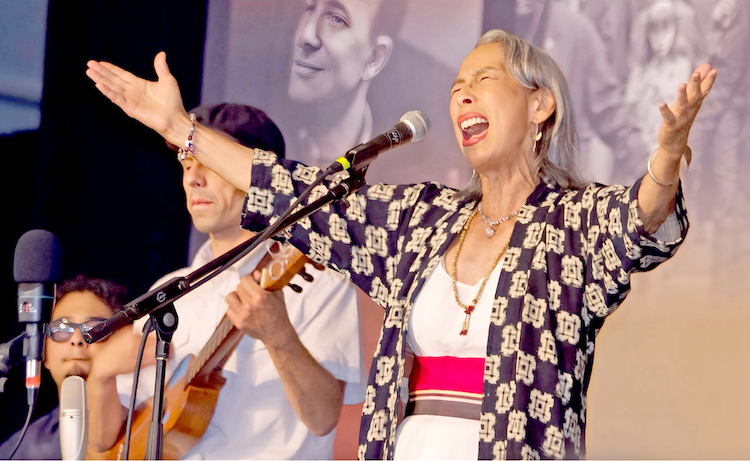
Nobuko Miyamoto, in her own words, views herself as an “artivist.” (Photo: Nobuko Miyamoto, courtesy of nobukomiyamoto.org)
A documentary film takes stock of the JANM honoree’s journey.
By Alex Luu, P.C. Contributor
It is an understatement to say that Nobuko Miyamoto has seen and done a lot.
Born in Los Angeles a few years shy of the beginning of World War II, Miyamoto and her family were rounded up and incarcerated at the Santa Anita racetrack. A natural and gifted dancer, she was only a teenager when she catapulted to Broadway productions such as “The Flower Drum Song” and classic Hollywood musicals “The King and I,” “Les Girls” and “West Side Story,” working with iconic stars Yul Brynner and Deborah Kerr, Gene Kelly and Rita Moreno and Natalie Wood, respectively. This impressive and prolific streak, however, barely scratches the surface of Miyamoto’s 70-plus decades (and counting) life and career.
See related article here.
In the opening scene of the 2024 documentary “Nobuko Miyamoto: A Song in Movement,” Miyamoto introduces herself with a self-deprecating laughter, “I’m Nobuko Miyamoto, what else do you want to know?”
And so begins the aural and visual portrait of an entertainer who finds her true calling with and within her own Asian American community, far from the glamour of the Great White Way and La La Land.
Directed by award-winning filmmaker Tadashi Nakamura, “Nobuko Miyamoto: A Song in Movement” has a standard structure that gives the viewer a chronological account of Miyamoto’s life through her music/lyrics, eye-opening interviews in which she recounts her experiences with wit and unapologetic candor and rarely seen archival footage.

Miyamoto and her songwriting/performing partner Chris Iijima (Photo: Nobuko Miyamoto courtesy of nobukomiyamoto.org)
Example: A clip from “The Mike Douglas Show” circa early 1970s in which Miyamoto (who at that time was still known as JoAnne) and her songwriting/performing partner Chris Iijima are introduced by John Lennon, who co-hosted the show with wife Yoko Ono for a week. Lennon’s nasal monotone cannot hide his earnest respect for the duo as he says, “These are two young people. They’re young singers named Chris and JoAnne, and beautiful singers, and they have a story to tell.”
Miyamoto and Iijima launch into their now iconic protest song “We Are the Children” to a mostly white studio audience. It is quite striking to see a famous Beatle not only introduce but also have immense praise for two relatively unknown singers/musicians; however, it is even more incredible to hear about this historic appearance from Miyamoto herself, not because of the rarity of seeing two Asian American faces on an immensely popular American TV show, but of what had actually transpired behind the scenes.
The show’s director had balked at some of the lyrics from “We Are the Children” — which contained references to “the concentration camps” — as being too controversial for a mainstream white audience (in the studio and at home) and suggested that Miyamoto render a more sanitized version.
This was typical of television at the time — it happened to the Rolling Stones (who acquiesced) and the Doors (who didn’t) when “The Ed Sullivan Show” wanted changes made to suggestive lyrics. A similar scenario played out at another hit from the time, “The Smothers Brothers Show.”
Faced with the choice to be like one of Bill Hosokawa’s “Quiet Americans” and cave in to the demands — or speak out for herself (and, to a great extent, the Asian American community), Miyamoto chose to speak truth to power.
“Out of nowhere, I just feel this rage building up in my body,” she recalled, “and I explode. ‘You! You put us in concentration camps, and you say we can’t sing this song?’ And I just turn around and walk away like I was gonna walk home, and before I hit the door of the studio, the director is running after me and he said, ‘No, it’s OK, you can sing anything you want!’”

Throughout her life, Miyamoto has also entrenched herself in the civil rights and social justice movements. (Photo: JANM/PBS SOCAL)
By this time in her career, Miyamoto had, for the most part, walked away from Hollywood. In an unexpected roundabout turn in her life and art, Miyamoto had become entrenched in the civil rights and social justice movements across the country. Having recently met the godmother of Asian American activism Yuri Kochiyama, Miyamoto was personally invited to a meeting for Asian Americans for Action in New York.
It was the first time that Miyamoto was made aware of and met Japanese American (and other Asian American) activists who were demonstrating and fighting alongside the Black Panthers for representation and social change in underrepresented and marginalized communities.
To Miyamoto, it was a wakeup call to reassess her own artistic output in relation to more real-world issues and injustices.
In a deft touch, the film intermixes black-and-white footage/stills of Miyamoto and fellow Asian American activists such as Kochiyama (as well as newfound friend and soon-to-be collaborator Iijima), the Black Panthers’ marches and Miyamoto’s on-camera interview.
Director Nakamura expertly underscores this visual tableau with one of Miyamoto and Iijima’s songs, “Something About Me Today,” from their band (along with Charlie Chin) Yellow Pearl that would go on to record the first-ever Asian American folk album, “A Grain of Sand.”
As the archival footage and stills of Miyamoto interacting with Kochiyama, Ijima and a cadre of young and hungry Asian American activists play across the screen, we hear Miyamoto’s singing the potent lyrics:
“I looked in the mirror
And I saw me
And I didn’t want to be any other way
Then I looked around
And I saw you
And it was the first time I knew
Who we really are.”
This moment in the film is perhaps its most revelatory one in that it shows exactly what led to Miyamoto’s life-changing decision to use her dancing, songwriting, voice and storytelling to positively uplift, educate, challenge and ultimately transform lives and communities.
Yet another defining moment in Miyamoto’s life would be the opposite of joy and celebration and instead be rooted in death and loss. In a soul-bearing scene, she momentarily revisits that tragedy with grief and tears, “It stays with you, and it motivates you, too, because I won’t stop . . . I won’t stop.”
There is so much more to see and know about Miyamoto that is best left for viewers of “Nobuko Miyamoto: A Song in Movement” to discover on their own. The film is definitely a must-see docu that is filled with inspirational songs, riveting stories and testimonials from a humble yet fierce Japanese American who has successfully combined art and activism — in her own words an “artivist” — who has made an indelible and profound difference in the fabric and culture of America.
Now at 85 years old and still traveling the country singing, dancing, speaking and sharing her wisdom to sold-out crowds, Miyamoto shows no signs of stopping. And that is a truly beautiful thing.
“Nobuko Miyamoto: A Song in Movement” can be seen for free on the PBS website at tinyurl.com/ye8h64e5.

Miyamoto has used her dancing, songwriting, voice and storytelling to positively uplift, educate and transform communities. (Photo: JANM/PBS SOCAL)



